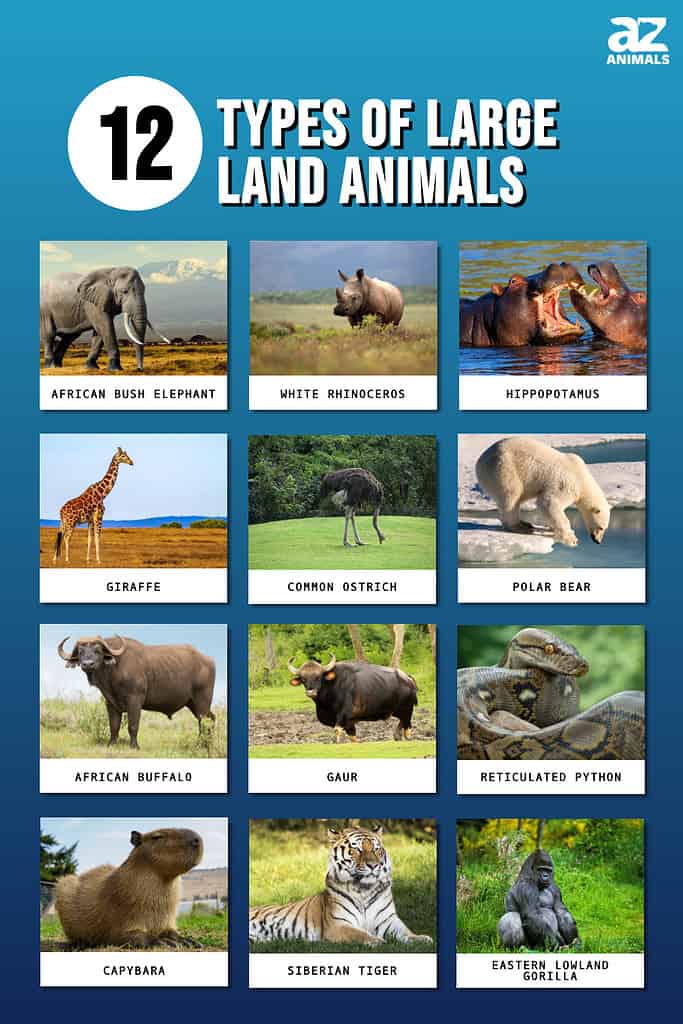
Land animals exist in countless environments, ecosystems, and biospheres. Thousands of species with all different lifestyles fall under the land animal umbrella. That makes it one of the largest categories of animals. They can be reptiles, mammals, herbivores, carnivores, nocturnal, warm-blooded, cold-blooded, and much more. These animals come in all shapes and sizes, and some of them can be incredibly massive. Here are 12 types of large land animals.
1. African Bush Elephant

As the largest land animal in the world, African bush elephants weigh between 6,600 and 13,000 pounds.
©Volodymyr Burdiak/Shutterstock.com
The African bush elephant is huge. In fact, it’s not only the largest elephant species but also the largest land animal in the entire world! Adult females weigh around 6,600 pounds, while adult males can reach up to 13,000 pounds. These elephants are the longest-living mammals other than humans, with a lifespan of around 70 years. They can reach up to 13 feet in height and 24 feet in length, towering above the other animals in the savanna.
African bush elephants are extremely powerful, with tusks able to lift more than 400 pounds of weight at once. They are herbivores, consuming mainly brush and leaves and eating around 350 pounds of them each day. These elephants travel in herds of mothers and their young, with males only joining during mating season. They have the longest gestation period of any other mammal, lasting almost 22 months!
2. White Rhinoceros

The large horn protruding from the center of their heads characterizes the white
rhinoceros
.
©JONATHAN PLEDGER/Shutterstock.com
The white rhinoceros is the second largest land animal, weighing between 3,080 and 7,920 pounds. Characterized by a large horn protruding from the center of their heads, white rhinos stand at a towering six feet tall. They roam the savannas of South Africa. These mammals often form groups of around 14 females and their calves and travel together throughout the wilderness. Male white rhinos defend their territory, usually around a singular square mile. They also patrol it during mating season to ensure that females do not leave.
These beasts are large but fairly agile, able to reach running speeds of up to 28 miles per hour. They usually have a lifespan of around 40 years in the wild but can live up to 50 in captivity. White rhinos are herbivores, spending almost half the day eating large quantities of grasses and weeds. They can live up to five days without drinking any water.
3. Hippopotamus
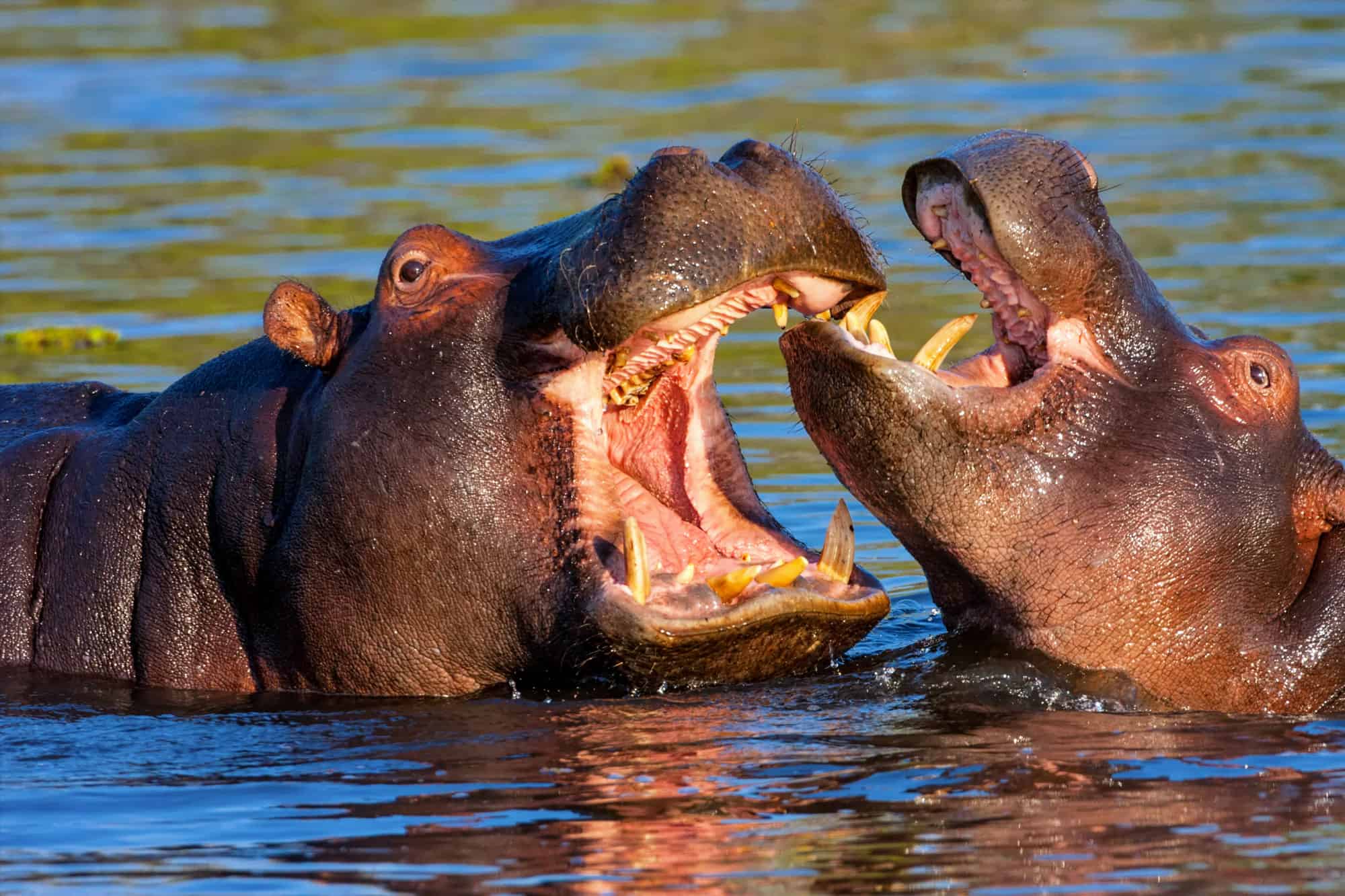
Hippos are highly aggressive and unpredictable, and they often charge other animals or even humans.
©iStock.com/mesut zengin
While it is still classified as a land animal, the hippopotamus is an incredibly powerful creature that lives in waterways like rivers and ponds. It lives in water in order to protect its extremely sensitive skin from the harsh African sun. Hippos are the world’s third largest land animal. They weigh up to 9,000 pounds with a height of five feet and a length of around 16 feet. Hippos can run up to 22 miles per hour across short distances in order to escape potential threats or reach a desired location.
They have an herbivorous diet, eating around 80 pounds of grass and fruit every evening during feeding time. Although they do not eat other animals, hippos are aggressive, able to defend their territory well with their powerful teeth. They live in pods of between 40 and 200 other hippos, marking their territory with large piles of their feces.
4. Giraffe

Reaching a height of 19 feet, giraffes are astonishing animals.
©Nicola_K_photos/Shutterstock.com
The tallest animal on this list, giraffes stand up to a staggering 19 feet in height. They weigh between 1,750 and 2,800 pounds and have a lifespan of around 25 years. Giraffes use their abnormal height to help them browse the treetops for leaves that the other animals can’t reach. This gives them an advantage in the food supply. Also aiding the species in food retrieval is their large tongue which is approximately 21 inches long.
Giraffes usually move in small groups of about six and live in open grasslands. Sometimes, male giraffes will use their long necks and heads to fight each other for dominance during mating season. Giraffes have a long gestation period of 15 months. That ensures calves are able to quickly stand up and move around after birth.
5. Common Ostrich

With powerful kicks, ostriches are capable of fighting off predators.
The ostrich, being the biggest bird on land, can stretch up to 9 feet in height and weighs up to 350 pounds. Due to their heavy weight, they are flightless birds, but strong runners, able to reach a speed of almost 45 miles an hour. Ostriches live in herds of around 12 and roam African savanna and desert lands. Alpha males look after their herd, and they mate with the dominant hen.
An ostrich diet usually consists of plants and seeds, but they will sometimes eat live animals including insects or lizards. The species has various predators such as hyenas, lions, and wild dogs. They often fight these predators off with a strong kick thanks to their powerful legs. Each of their legs has a long and sharp claw which helps them fight off any potential threats.
6. Polar Bear
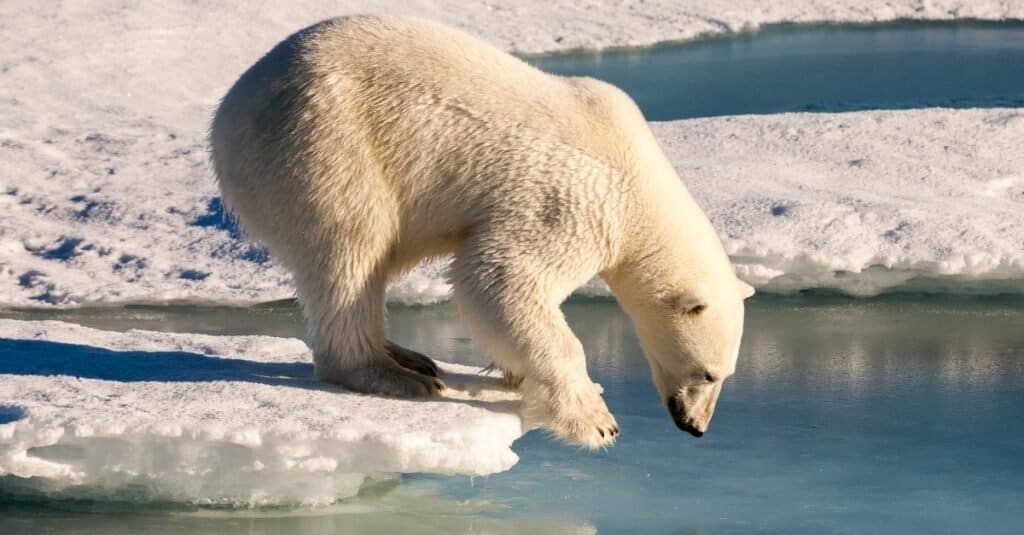
Polar bears are the world’s largest extant bears.
©Mario_Hoppmann/Shutterstock.com
The polar bear holds the title of the world’s largest land carnivore. These arctic mammals are approximately eight feet long and can weigh between 900 to 1,600 pounds. Polar bears live along shores on sea ice and can be found in parts of Canada, Alaska, Russia, Greenland, and Norway. They maintain a carnivorous diet of mostly seals. Hunting includes waiting around gaps in the ice where a seal may come up for air and then pouncing at the right moment.
While polar bears live on the land, they are also very strong swimmers because of their large and slightly webbed front paws. They usually travel on their own after the first three years of their life and are solitary animals, aside from brief encounters for mating.
7. African Buffalo
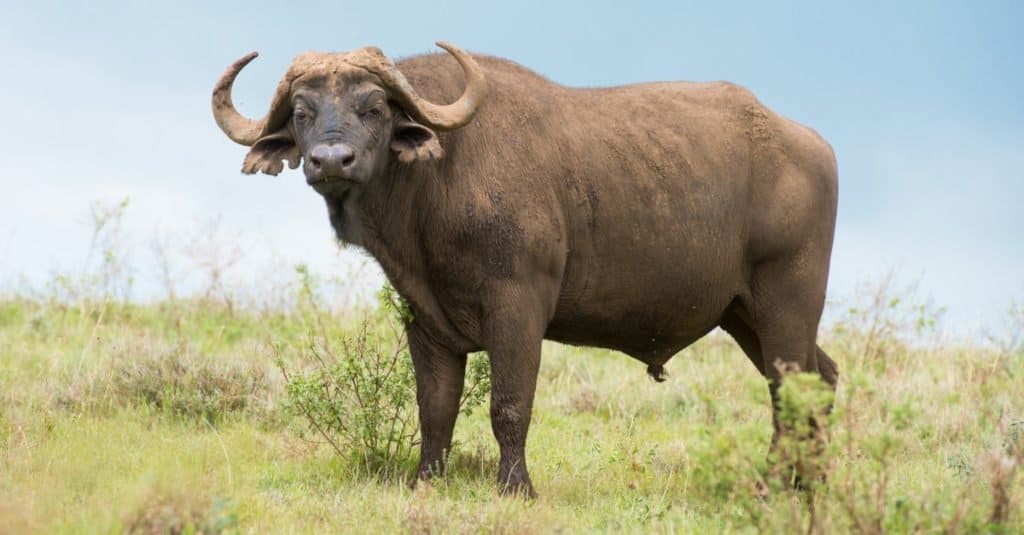
Herds of African buffalo can be anywhere between 50 and 500.
©BonnieBC/Shutterstock.com
One of the heaviest land animals is the African buffalo, weighing in at about 660 to 1,840 pounds. This species of buffalo is approximately five feet tall and has a life span of 11 to 22 years. The African buffalo divides into four distinct subspecies: the cape buffalo, the forest buffalo, the West African savanna buffalo, and the Central African savanna buffalo. African buffalo are herbivores and spend most of their time eating grass and chewing cud, which provides extra nutrients.
They live in many different types of habitats all over various African countries and travel in large herds between 50 and 500. These herds also get larger during the rainy season to intimidate predators. Their dangers are not limited to natural predators but they are “near threatened” according to the International Union for the Conservation of Nature because of poaching.
8. Gaur
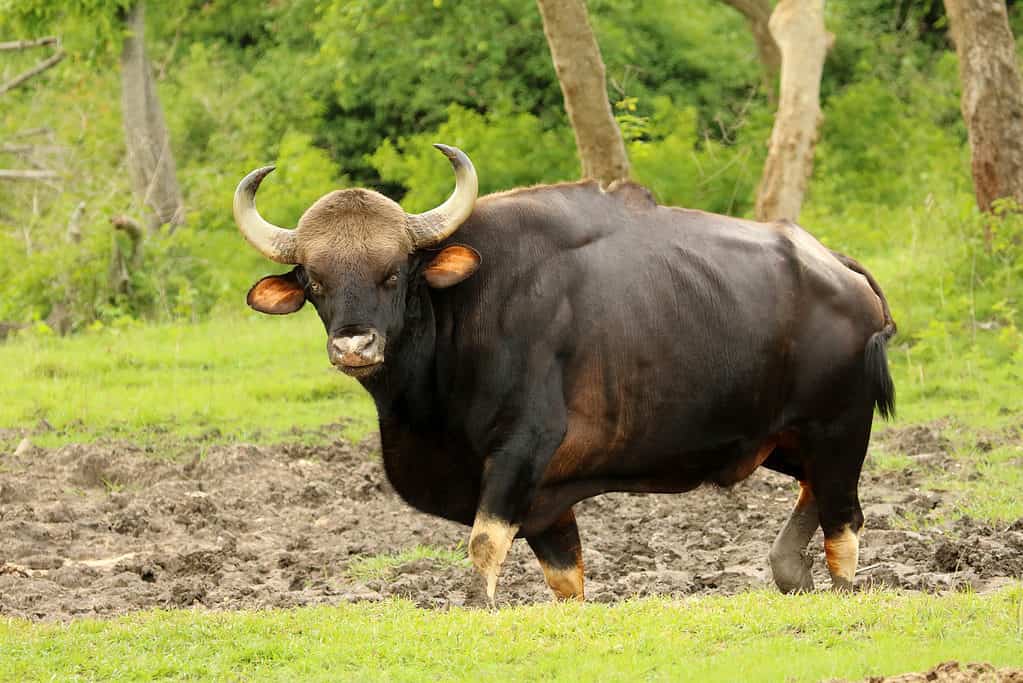
The title of largest wild cattle in the world goes to the gaur.
©RealityImages/Shutterstock.com
Native to Southeast Asia, the gaur is the largest type of wild cattle in the world. Adult gaurs weigh between 1,400 and 2,200 pounds and stand between five and seven feet tall. Gaurs have a lifespan of around 25 years and travel in herds of eight or more. Gaur herds consist of all females and one dominant male, roaming a home range of around 30 square miles.
Male gaurs, referred to as bulls, often congregate in their own herds, fighting off predators and other potential threats with their long, curved horns. These creatures are herbivores, feeding off of mainly grasses and leaves found in their expansive grassland habitats. They follow a polygynous mating style, with males mating with more than one female every season. A 280-day gestation period produces one calf, which usually weighs around 50 pounds. Gaurs are extremely shy animals but can become incredibly aggressive when provoked, often attacking and neutralizing any potential threats with their large horns.
9. Reticulated Python
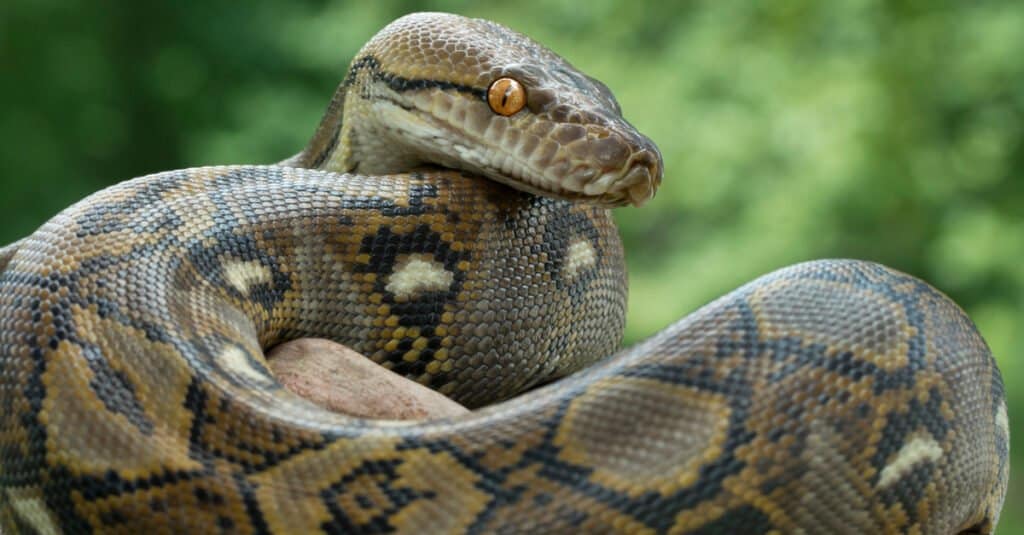
The reticulated python can grow up to 30 feet.
©Mark_Kostich/Shutterstock.com
The reticulated python is massive, weighing up to 320 pounds and measuring between 16 and 29 feet in length. They are native to the rainforests of southeast Asia, feeding on birds, deer, bats, and even bears in order to satisfy their carnivorous diet. Reticulated pythons usually live between 15 and 22 years, but can live up to 32 years when in captivity. Reticulated pythons are polyandrous, and mate every one to three years. They have an average gestation period of around 70 days, where females will incubate 25 to 80 eggs that then hatch.
These reptiles are able to contract and unfold their bodies voluntarily, allowing them to travel across the forest floor quickly as well as climb trees in order to form nests and catch prey. They have fairly poor hearing and restricted eyesight, meaning they rely mainly on touch and smell in order to locate prey. They also create vibrations along the forest floor in order to communicate with one another and find potential mates.
10. Capybara

Weighing between 77 and 143 pounds, capybaras are the largest rodent in the world.
©iStock.com/Dave Matchett
The capybara is the largest rodent on Earth. They are native to South America, although some have begun migrating to Florida. Capybaras weigh between 77 and 143 pounds and stand at around two feet in height. They have a lifespan of around seven years in the wild. Capybaras are herbivores, consuming mainly grasses and some aquatic plants. Capybaras’ teeth grow continuously throughout their lives, so they often scrape their teeth on rough plants and weeds in order to maintain a consistent shape. Adult capybaras can eat around eight pounds of grass daily, and every morning capybaras consume their own feces in order to help them digest the fibers in the grasses they consume, which is incredibly unique and unusual.
These rodents often live together in groups that can grow as large as 40. Female capybaras produce a little of around four babies annually, with a mating season that varies depending on the rodents’ respective ecosystems.
11. Siberian Tiger
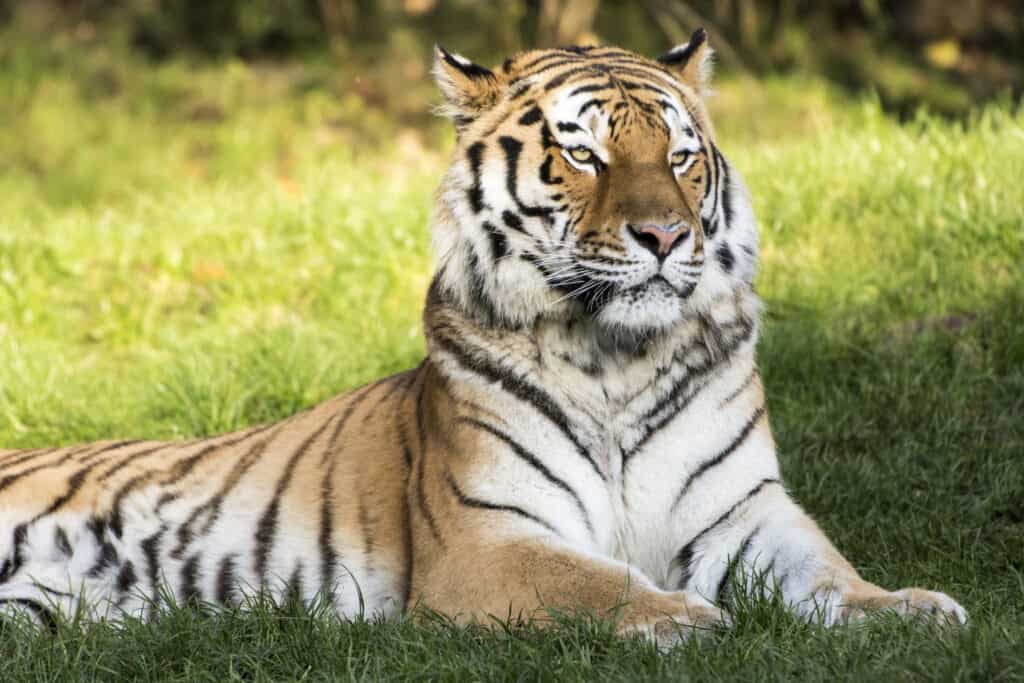
There are only about 600
Siberian
tigers left in the world.
©Gerckens-Photo-Hamburg/Shutterstock.com
Siberian tigers are the largest cats on Earth, with females weighing around 370 pounds and males weighing up to 930 pounds. They range in length from around eight feet up to a staggering 12 feet from head to tail. These cats are native to the forests of eastern Russia and northeastern China, although only around 600 Siberian tigers are left in the wild. Siberian tigers are carnivores, often hunting large mammals found in their natural habitats daily. They usually eat around 20 pounds of meat in one sitting, but can eat up to 60 pounds after a successful hunt!
Female tigers give birth once every two years to two to six cubs after a gestation period of around three and a half months. After three months of being nurtured by their mothers, the cubs are able to leave their den in order to help with hunting and explore the surrounding wilderness. The Siberian tiger has an average lifespan of around 15 years in the wild but can live up to 25 years when in captivity.
12. Eastern Lowland Gorilla
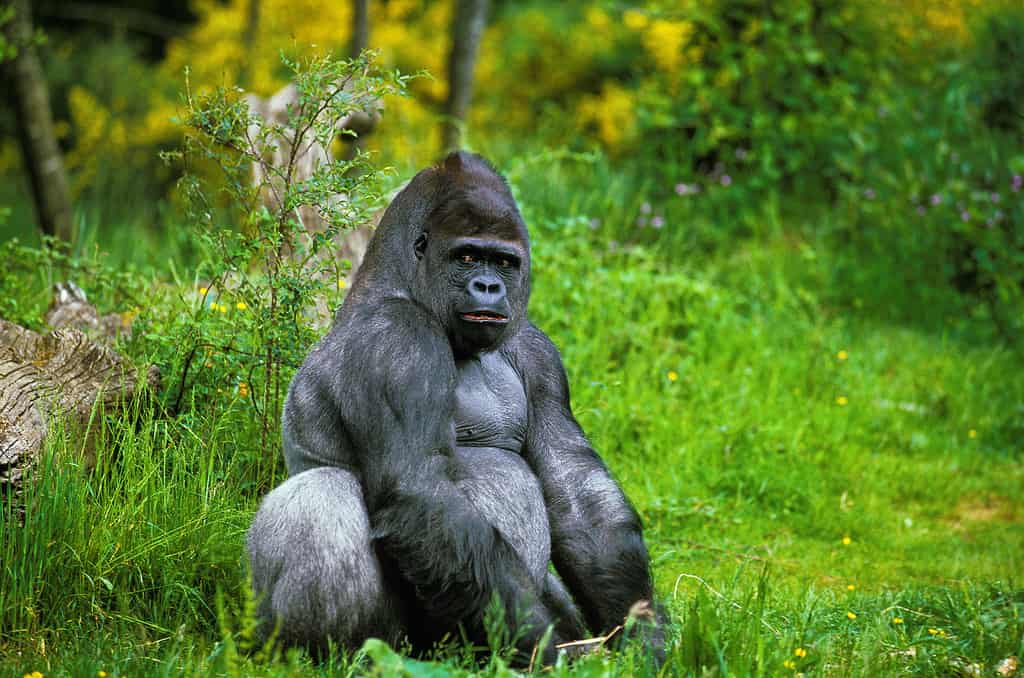
While their average weight is 360 pounds, eastern lowland gorillas can reach over 500 pounds in captivity.
©slowmotiongli/Shutterstock.com
Native to the eastern region of the Democratic Republic of Congo, the eastern lowland gorilla is the largest primate in the entire world. Adult male gorillas stand at a height of around five and a half feet. They have an average weight of 360 pounds but can reach up to 550 pounds in captivity. Female gorillas are much smaller, standing at around five feet and weighing 180 pounds on average.
These primates are mainly herbivores, consuming a variety of plants, fruits, and leaves in the forests they call home. Occasionally feeding on small insects such as ants and termites, these gorillas love to eat. In fact, they eat around 40 pounds of food each day.
Eastern lowland gorillas are polygamous, mating with several different partners over the course of their lives. After a gestation period of around eight and a half months, female gorillas will give birth to one offspring, which stays with them and the father until reaching maturity and going off to find its own group. These gorillas have an average lifespan of 35 years in the wild but can live up to 50 years when in captivity.
Conclusion
Land animals have thousands of different characteristics, lifestyles, and unique features that distinguish them. Many large animals on this list are becoming endangered, which is why it is important to learn about them and the resources available to ensure these species remain safe.
Summary of 12 Types of Large Land Animals
| Large Animal | Weight | |
|---|---|---|
| 1 | African Bush Elephant | Up to 13,000 pounds |
| 2 | White Rhinoceros | Up to 7,920 pounds |
| 3 | Hippopotamus | Up to 9,000 pounds |
| 4 | Giraffe | Up to 2,800 pounds |
| 5 | Common Ostrich | Up to 350 pounds |
| 6 | Polar Bear | Up to 1,600 pounds |
| 7 | African Buffalo | Up to 1,840 pounds |
| 8 | Gaur | Up to 2,200 pounds |
| 9 | Reticulated Python | Up to 320 pounds |
| 10 | Capybara | Up to 143 pounds |
| 11 | Siberian Tiger | Up to 930 pounds |
| 12 | Eastern Lowland Gorilla | Up to 550 pounds |
The photo featured at the top of this post is © iStock.com/fotografie-kuhlmann
Thank you for reading! Have some feedback for us? Contact the AZ Animals editorial team.






